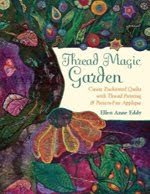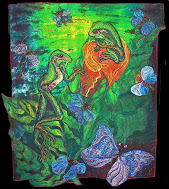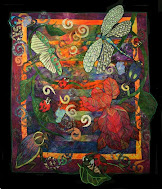Monday, July 12, 2010
Color Theory for Thread: Basic Shading for Embroidered Appliqué
When I embroidery images,every so often someone will say to me, "Do you really need all those threads?"Well of course!
Now, don't be silly. We know the answer to the age old question, "How many mushrooms do you put in a quiche?" The answer, of course, is" How many mushrooms do you have?"
But it's not exactly that reason. You don't pull in a million colors because you could. You do because it's how nature is. It's all about variance.
If you're going to shade something, you start with some color decisions. First we zone our design. Zones are areas that are fundamentally different colors.His tail and eye ring are one zone, his body and his ear others. His eye is separate because we'll do it in Sliver thread to make it shiny.
In each zone, you'll need a dark, medium and light value. If it's a larger piece you can have separate out your areas as having darks mediums and lights of their own. I've drawn lines to separate the areas, but they're not hard and fast. I'll just start adding lighter threads into the mix at those lines.
To weight the embroidery, I'll add a shader at the bottom of each area. A shader can be a darker complement to the color or dark blue, grey, brown, green or purple.
To lift the color and make it more exciting, we'll add a shocker right before the last color. It can be a bright complement to the basic color or orange, lime, hot pink, or bright purple.
Here's the range of colors I chose for this squirrel. He's basically orange, but all those colors go into making him shine and shimmer. Purple is my shader and the blues make a great shocker to keep the eye happy and entertained.
Wrapping it up:
Now, don't be silly. We know the answer to the age old question, "How many mushrooms do you put in a quiche?" The answer, of course, is" How many mushrooms do you have?"
But it's not exactly that reason. You don't pull in a million colors because you could. You do because it's how nature is. It's all about variance.
If you're going to shade something, you start with some color decisions. First we zone our design. Zones are areas that are fundamentally different colors.His tail and eye ring are one zone, his body and his ear others. His eye is separate because we'll do it in Sliver thread to make it shiny.
In each zone, you'll need a dark, medium and light value. If it's a larger piece you can have separate out your areas as having darks mediums and lights of their own. I've drawn lines to separate the areas, but they're not hard and fast. I'll just start adding lighter threads into the mix at those lines.
To weight the embroidery, I'll add a shader at the bottom of each area. A shader can be a darker complement to the color or dark blue, grey, brown, green or purple.
To lift the color and make it more exciting, we'll add a shocker right before the last color. It can be a bright complement to the basic color or orange, lime, hot pink, or bright purple.
Here's the range of colors I chose for this squirrel. He's basically orange, but all those colors go into making him shine and shimmer. Purple is my shader and the blues make a great shocker to keep the eye happy and entertained.
Wrapping it up:
- Pick a wide range of colors from dark to light for each zone. Go way lighter than you intend for highlights and way darker than you might to weight the piece.
- Pick a complement or very dark color to shade your piece.
- Pick a complement or very bright color to shock your shades.
- End with the color you want to see the most. You will.
Color Theory for Thread: Basic Shading for Embroidered Appliqué
When I embroidery images,every so often someone will say to me, "Do you really need all those threads?"Well of course!
Now, don't be silly. We know the answer to the age old question, "How many mushrooms do you put in a quiche?" The answer, of course, is" How many mushrooms do you have?"
But it's not exactly that reason. You don't pull in a million colors because you could. You do because it's how nature is. It's all about variance.
If you're going to shade something, you start with some color decisions. First we zone our design. Zones are areas that are fundamentally different colors.His tail and eye ring are one zone, his body and his ear others. His eye is separate because we'll do it in Sliver thread to make it shiny.
In each zone, you'll need a dark, medium and light value. If it's a larger piece you can have separate out your areas as having darks mediums and lights of their own. I've drawn lines to separate the areas, but they're not hard and fast. I'll just start adding lighter threads into the mix at those lines.
To weight the embroidery, I'll add a shader at the bottom of each area. A shader can be a darker complement to the color or dark blue, grey, brown, green or purple.
To lift the color and make it more exciting, we'll add a shocker right before the last color. It can be a bright complement to the basic color or orange, lime, hot pink, or bright purple.
Here's the range of colors I chose for this squirrel. He's basically orange, but all those colors go into making him shine and shimmer. Purple is my shader and the blues make a great shocker to keep the eye happy and entertained.
Wrapping it up:
Now, don't be silly. We know the answer to the age old question, "How many mushrooms do you put in a quiche?" The answer, of course, is" How many mushrooms do you have?"
But it's not exactly that reason. You don't pull in a million colors because you could. You do because it's how nature is. It's all about variance.
If you're going to shade something, you start with some color decisions. First we zone our design. Zones are areas that are fundamentally different colors.His tail and eye ring are one zone, his body and his ear others. His eye is separate because we'll do it in Sliver thread to make it shiny.
In each zone, you'll need a dark, medium and light value. If it's a larger piece you can have separate out your areas as having darks mediums and lights of their own. I've drawn lines to separate the areas, but they're not hard and fast. I'll just start adding lighter threads into the mix at those lines.
To weight the embroidery, I'll add a shader at the bottom of each area. A shader can be a darker complement to the color or dark blue, grey, brown, green or purple.
To lift the color and make it more exciting, we'll add a shocker right before the last color. It can be a bright complement to the basic color or orange, lime, hot pink, or bright purple.
Here's the range of colors I chose for this squirrel. He's basically orange, but all those colors go into making him shine and shimmer. Purple is my shader and the blues make a great shocker to keep the eye happy and entertained.
Wrapping it up:
- Pick a wide range of colors from dark to light for each zone. Go way lighter than you intend for highlights and way darker than you might to weight the piece.
- Pick a complement or very dark color to shade your piece.
- Pick a complement or very bright color to shock your shades.
- End with the color you want to see the most. You will.
Friday, July 2, 2010
Musings:Art Outside the Box: Fantasy Land vs The Real Thing
"Wouldn't it be rather a pull sometimes to have--a--to haven?" He hung fire; he wanted me to help him by phrasing what he meant. But I couldn't--I didn't know. So he brought it out awkwardly: "The REAL thing;"....
She was always a lady certainly, and into the bargain was always the same lady. She was the real thing, but always the same thing.
Henry James, The Real Thing
I often find myself caught on the accuracy issue. If your work is based in some kind of reality, you really do need to figure out how much reality you want in it. Some of this is constitutional. Some of it is artist's license. Most of it is a statement louder than words.
Realism is always impressive. It bespeaks of excellent drawing skills and a keen eye. It's more impressive when we see it outside the standard art forms. It's great to draw a frog in pencil, or charcoal or paint. It's a whole other thing to do it in thread.It's also worth saying there really are blue frogs.
But realism always falls a bit flat for me. I know it's a brown frog. Couldn't it be red instead? But couldn't it have purple shadows? Green highlights? A bit of orange around the eyes?All of a sudden that frog has a rainbow quality that is definitely not realism.
I could say it was strictly a color issue but that's not true either. What makes this frog definately not the real thing is those lovely red lips. Frogs don't have lips. So the lips themselves become a statement on how human our frog is.
And there are those moments when reality simply isn't as much fun.
Patti Culea is my favorite doll artist. She's also a kindred spirit. When she asked me if I could do a quilt for her book Creative Cloth Explorations: Adventures in Fairy-Inspired Fiber Art, I wanted to. I just was a bit unsure about creating fairies. So I asked her, " Do your fairies have a quality ride?" All fairies are royalty. It's part of their job. So they can't be going shank's mare or rickshaw. They needed the best fairy frog I could do.
Well, by the time you've put wings on it, reality has pretty much flown out the window. But the fun hasn't.
Don't be caught by the trap of reality. Like fire, it's a good servant and a poor master. Use it while it serves you and leave it whenever it just doesn't have enough luster to lighten things up.
You'll find A Noble Steed in Patti's book on Amazon.com. Her web page is at PMC Designs.
Subscribe to:
Posts (Atom)
Ellen Anne Eddy's Flowers on Youtube.com
Labels
lunatic fringe
(22)
design
(18)
life as an artist
(18)
lifestyle
(18)
story telling
(11)
art quilting
(8)
fiber art
(8)
art quilters
(7)
books
(6)
color
(6)
free motion
(6)
gardening
(5)
Thread Magic Garden
(4)
embroidery
(4)
quilters
(4)
quilting
(4)
C and T Publishing
(3)
craft
(3)
flowers
(3)
Christmas
(2)
What problem?
(2)
archetypes
(2)
beads
(2)
bias
(2)
bobbin work
(2)
classes
(2)
filling the grid
(2)
sewing
(2)
threads
(2)
zigzag stitch
(2)
Wizard of Oz
(1)
choir
(1)
knitting
(1)
machine stitching
(1)
movies
(1)
seasons
(1)
youtube
(1)
Like us on Facebook
Quiltposium, Fall2011

Ellen's New Article, Dance of Design
Essential Embroidery Stitches: Free Hand and Machine Embroidery Designs and Techniques.
The Butterfly Effect

My Blog List
-
5 days ago
-
1 week ago
-
1 month ago
-
4 months ago
-
6 months ago
-
8 months ago
-
3 years ago
-
3 years ago
-
3 years ago
-
4 years ago
-
5 years ago
-
5 years ago
-
6 years ago
-
7 years ago
-
7 years ago
-
7 years ago
-
7 years ago
-
8 years ago
-
9 years ago
-
9 years ago
-
9 years ago
-
9 years ago
-
10 years ago
-
10 years ago
-
10 years ago
-
10 years ago
-
11 years ago
-
11 years ago
-
11 years ago
-
11 years ago
-
11 years ago
-
11 years ago
-
11 years ago
-
11 years ago
-
12 years ago
-
-
-

Facebook Badge
Labels
archetypes
(2)
art quilters
(7)
art quilting
(8)
beads
(2)
bias
(2)
bobbin work
(2)
books
(6)
C and T Publishing
(3)
choir
(1)
Christmas
(2)
classes
(2)
color
(6)
craft
(3)
design
(18)
embroidery
(4)
fiber art
(8)
filling the grid
(2)
flowers
(3)
free motion
(6)
gardening
(5)
knitting
(1)
life as an artist
(18)
lifestyle
(18)
lunatic fringe
(22)
machine stitching
(1)
movies
(1)
quilters
(4)
quilting
(4)
seasons
(1)
sewing
(2)
story telling
(11)
Thread Magic Garden
(4)
threads
(2)
What problem?
(2)
Wizard of Oz
(1)
youtube
(1)
zigzag stitch
(2)



.jpg)












